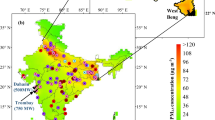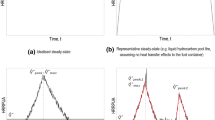Abstract
Fire events and the related toxicants such as CO are responsible for many fatalities in the current century. These hazardous events are much more dangerous when they occur in enclosed spaces. In the present study, a theoretical relation is developed for horizontal distribution of CO in a large tunnel fire. Then, the developed criterion is used to study the effect of some rudimentary parameters such as the heat release rate (HRR) of fire and tunnel’s aspect ratio (AR) on CO and temperature stratification. Theoretical results of various heat release rates and aspect ratios for horizontal distribution of CO are compared with numerical results using fire dynamics simulator (FDS5.5). It is found that big fires have higher rates of CO concentration decay in comparison to the smaller ones due to higher air entrainment into the travelling plume. It is indicated that the smoke travelling at higher values of tunnel AR, dilutes faster. Moreover, using FDS5.5, the relevant variations in temperature and CO concentration are discussed for tunnel angles ranging from −20° to 20°.
Similar content being viewed by others
References
F. Vuilleumier, A. Weatherill and B. Crausaz, Safety aspects of railway and road tunnel: Example of the lotschberg railway tunnel and mont-blanc road tunnel, Tunnelling and Underground Space Technology, 17 (2002) 153–158.
W. H. Hong, The progress and controlling situation of daegu subway fire disaster, 6th Asia-Oceania Symposium on Fire Science and Technology, Daegu, Korea (2004) 28–46.
Y. Huang, T. H. Hong and C. N. Kim, A numerical simulation of train-induced unsteady airflow in a tunnel of Seoul subway, Journal of Mechanical Science and Technology, 26(3) (2012) 785–792.
M. M. Hirschler, Smoke toxicity measurements made so that the results can be used for improved fire safety, Journal of Fire Sciences, 9(4) (1991) 330–47.
J. S. Newman, Experimental evaluation of fire-induced stratification, Combustion and Flame, 57(1) (1984) 33–39.
J. Zhang, Y. Lizhong, X. Qinkun and L. Xiao, Experimental study on CO distribution in the reduced-scale tunnel fire under longitudinal ventilation, Journal of Applied Fire Science, 20(1) (2010) 1–19.
L. H. Hu, D. Yang, Y. Q. Jiang, R. Huo and S. Liu, A com parative study on vertical profiles of smoke temperature and carbon monoxide concentration in a tunnel fire, Journal of Applied Fire Science, 17(1) (2007) 21–35.
L. H. Hu, F. Tang, D. Yang, S. Liu and R. Huo, Longitudinal distributions of CO concentration and difference with temperature field in a tunnel fire smoke flow, International Journal of Heat and Mass Transfer, 53(13–14) (2010) 2844–855.
D. Yang, R. Huo, X. l. Zhang, S. Zhu and X. Y. Zhao, Comparative study on carbon monoxide stratification and thermal stratification in a horizontal channel fire, Building and Environment, 49 (2012) 1–8.
D. Yang, R. Huo, X. L. Zhang and X. Y. Zhao, Comparison of the distribution of carbon monoxide concentration and temperature rise in channel fires: reduced-scale experiments, Applied Thermal Engineering, 31(4) (2011) 528–36.
Y. Lizhong, F. Wenxing and Y. Junqi, Experimental research on the spatial distribution of toxic gases in the transport of fire smoke, Journal of Fire Sciences, 26(1) (2008) 45–62.
Y. Oka, Control of smoke flow in tunnel fires, Fire Safety Journal, 25(4) (1995) 305–22.
Y. Wu, H. J. Xing and G. T. Atkinson, ’Interaction of fire plume with inclined surface, Fire Safety Journal, 35 (2000) 391–403.
C. Hwang and J. Edwards, The critical ventilation velocity in tunnel fires-a computer simulation, Fire Safety Journal, 40(3) (2005) 213–44.
J. Zhang, X. Zhou, Q. Xu and L. Yang, The inclination effect on CO generation and smoke movement in an inclined tunnel fire, Tunnelling and Underground Space Technology, 29 (2012) 78–84.
L. H. Hu, R. Huo and W. K. Chow, Studies on buoyancydriven back-layering flow in tunnel fires, Experimental Thermal and Fluid Science, 32(8) (2008) 1468–1483.
L. H. Hu, R. Huo, W. K. Chow, H. B. Wang and R. X. Yang, Decay Of buoyant smoke layer temperature along the longitudinal direction in tunnel fires, Journal of Applied Fire Science, 13(1) (2004) 53–77.
J. P. Kunsch, Critical velocity and range of a fire-gas plume in a ventilated tunnel, Atmospheric Environment, 33 (1999) 13–24.
Q. Zhang, X. Guo, E. Trussoni, G. Astore, S. Xu and P. Grasso, Theoretical analysis on plane fire plume in a longitudinally ventilated tunnel, Tunnelling and Underground Space Technology, 30 (2012) 124–131.
O. Megret and O. Vauquelin, A model to evaluate tunnel fire characteristics, Fire Safety Journal, 34 (2000) 393–401.
L. H. Hu, R. Huo, H. Wang, Y. Li and R. Yang, Experimental studies on fire-induced buoyant smoke temperature distribution along tunnel ceiling, Building and Environment, 42(11) (2007) 3905–915.
M. Delichatsios, The flow of fire gases under a beamed ceiling, Combustion and Flame, 43 (1981) 1–10.
C. Koslowski and V. Motevalli, Behavior of a 2-dimensional ceiling jet flow: A beamed ceiling configuration, Fire Safety Science, 4 (1994) 469–80.
L. Li, X. Cheng, X. Wang and H. Zhang, Temperature distribution of fire-induced flow along tunnels under natural ventilation, Journal of Fire Science, 30 (2012) 122–137.
D. Drysdale, An introduction to fire dynamics, Chichester, West Sussex: Wiley (2011).
B. Karlsson and J. G. Quintiere, Enclosure fire dynamics, Boca Raton, FL: CRC (2000).
D. Xilin, Z. Weifeng and Q. Lijun, The calculation of the safe unsealing time after suppressing the tunnel fire, Fire Science and Technology, 2 (1999) 4–7.
D. Xilin and Y. Gaofeng, Oxygen-lacking combustion in tunnel fire, Fire Science and Technology, 4 (2000) 4–6.
H. Hengdong, Variation of smoke temperature and smoke pressure and the corresponding fire protection engineering for underground fires, Journal of Chongqing Institute of Architecture and Engineering, 17 (1995) 68–73 (in Chinese).
K. B. McGrattan and G. P. Forney, Fire dynamics simulator (Version 4.07) — User’s guide, NIST Special Publication 1019, National Institute of Standards and Technology, Gaithersburg, MD (2006).
M. Kevin, K. Bryan and H. Simo, Fire dynamics simulator (Version 5) user’s guide, National Institute of Standards and Technology Special Publication (2007).
P. A. Friday and F. W. Mowrer, Comparison of FDS model predictions with FM/SNL fire test data, NISTGCR01-810, National Institute of Standards and Technology, Gaithersburg, MD (2001).
K. B. McGrattan and A. Hamins, Numerical simulation of the howard street tunnel fire, Baltimore, Maryland, July 2001. NISTIR 6902, National Institute of Standards and Technology, (2002).
A. A. F. Peters and R. Weber, Mathematical modelling of a 2.25MW swirling natural gas flame, Part 1: Eddy break-up concept for turbulent combustion; probability density function approach for nitric oxide formation, Combust. Sci. Tech. 110–111 (1995) 67–101.
O. Vauquelin and Y. Wu, Influence of tunnel width on longitudinal smoke control, Fire Safety Journal, 41(6) (2006) 420–26.
S. Lee and H. Ryou, A numerical study on smoke movement in longitudinal ventilation tunnel fires for different aspect ratio, Building and Environment, 41(6) (2006) 719–25.
ASHRAE Han dbook, Atlanta, GA: American Society of Heating, Refrigeratingand Air Conditioning Engineers (1998).
Author information
Authors and Affiliations
Corresponding author
Additional information
Recommended by Associate Editor Jun Sang Park
Atta Sojoudi received B.S. degree (with highest honors) from Tabriz University in 2012, and now is M.S.c student in the Mechanical Engineering Department at Sharif University of Technology (SUT) under the supervision of Professor Bijan Farhanieh. His research interests are numerical studies in fluid mechanics and heat and mass transfer.
Rights and permissions
About this article
Cite this article
Sojoudi, A., Afshin, H. & Farhanieh, B. An analysis of carbone monoxide distribution in large tunnel fires. J Mech Sci Technol 28, 1917–1925 (2014). https://doi.org/10.1007/s12206-014-0339-4
Received:
Revised:
Accepted:
Published:
Issue Date:
DOI: https://doi.org/10.1007/s12206-014-0339-4




